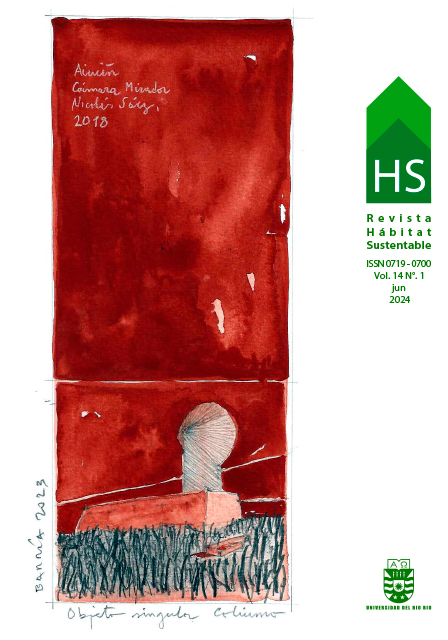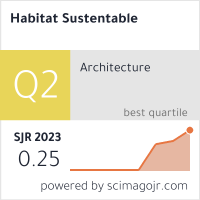Percepción térmica de usuarios en la vivienda vernácula de la comunidad Uro del lago Titicaca en Perú
DOI:
https://doi.org/10.22320/07190700.2024.14.01.02Palabras clave:
vivienda vernácula, confort térmico, percepción térmica, condición climáticaResumen
El objetivo de la siguiente investigación fue realizar un estudio de campo, para conocer la percepción térmica de los usuarios de la vivienda vernácula en clima frío de la región Altoandina peruana. Las unidades analizadas fueron viviendas construidas en base a “totora” de la comunidad Uro. El estudio de campo desarrollado consistió en caracterizar el desempeño térmico de la vivienda, determinar la superficie corporal y aislamiento de ropa, valorar la sensación, preferencia y aceptabilidad térmica, determinar las estrategias de ajustes personales y calcular la temperatura neutra. Se recogieron 78 encuestas válidas en dos períodos estacionarios (verano e invierno). Los resultados revelan que, los usuarios de la vivienda se encuentran incómodos. La preferencia apunta a ambientes más cálidos y secos. La temperatura neutra en verano fue de 19.62 ºC y en invierno de 21.98 ºC. Los habitantes del lugar evidenciaron tener la expectativa que el ambiente puede mejorarse térmicamente con mayor aislamiento.
Descargas
Citas
ABDOLLAHZADEH, S. M., HEIDARI, S., y EINIFAR, A. (2023). Evaluating thermal comfort and neutral temperature in residential apartments in hot and dry climate: A case study in Shiraz, Iran. Journal of Building Engineering, 76. https://doi.org/10.1016/j.jobe.2023.107161
ANSI/ASHRAE 55. (2017). ANSI/ASHRAE Standard 55-2017: Thermal Environmental Conditions for Human Occupancy. ASHRAE Inc., 2017, 66. https://doi.org/ISSN 1041-2336
AZA-MEDINA, L. C., PALUMBO, M., LACASTA, A. M., y GONZÁLEZ-LEZCANO, R. A. (2023). Characterization of the thermal behavior, mechanical resistance, and reaction to fire of totora (Schoenoplectus californicus (C.A. Mey.) Sojak) panels and their potential use as a sustainable construction material. Journal of Building Engineering, 69, 105984. https://doi.org/10.1016/j.jobe.2023.105984
CAMUFFO, D. (2019). Temperature: A Key Variable in Conservation and Thermal Comfort. Microclimate for Cultural Heritage, (3)15–42. https://doi.org/10.1016/b978-0-444-64106-9.00002-x
CHANG, S., HE, W., YAN, H., YANG, L., y SONG, C. (2021). Influences of vernacular building spaces on human thermal comfort in China’s arid climate areas. Energy and Buildings, 244. https://doi.org/10.1016/j.enbuild.2021.110978
COSTA-CARRAPIÇO, I., GONZÁLEZ, J. N., RASLAN, R., y SÁNCHEZ-GUEVARA, C. (2022). Understanding the challenges of determining thermal comfort in vernacular dwellings: A meta-analysis. Journal of Cultural Heritage, 58, 57–73. https://doi.org/10.1016/j.culher.2022.09.019
FANGER, P. (1970). Thermal Comfort, Analysis and Applications in Environmental Engineering: Vol. I. En McGraw-Hill Book Company, (1ª ed., Vol. 1). R.E. Krieger Pub. Co. https://www.abebooks.com/9780070199156/Thermal-comfort-analysis-applications-environmental-0070199159/plp
GRIFFITHS, I. D. (1991). Thermal comfort in buildings with passive solar features: field studies: Vol. I (Commission of the European Communities, Ed.; 1 Volume). Commission of the European Communities.
HIDALGO-CORDERO, J. F., y AZA-MEDINA, L. C. (2023). Analysis of the thermal performance of elements made with totora using different production processes. Journal of Building Engineering, 65. https://doi.org/10.1016/j.jobe.2022.105777
HIDALGO-CORDERO, J. F., NĚMEC, M., CASTRO, P. H., HÁJKOVÁ, K., CASTRO, A. O., y HÝSEK, Š. (2023). Macromolecular Composition of Totora (Schoenoplectus californicus. C.A. Mey, Sojak) Stem and Its Correlation with Stem Mechanical Properties. Journal of Natural Fibers, 20(2). https://doi.org/10.1080/15440478.2023.2282049
HUMPHREYS, M. A., y NICOL, J. F. (1970). An investigation into thermal comfort of office workers. Journal of the Institute of Heating and Ventilating Engineers, 38, 181–189.
HÝSKOVÁ, P., GAFF, M., HIDALGO-CORDERO, J. F., y HÝSEK, Š. (2020). Composite materials from totora (Schoenoplectus californicus. C.A. Mey, Sojak): Is it worth it? Composite Structures, 232. https://doi.org/10.1016/j.compstruct.2019.111572
ISO 7726 (1998). Ergonomics of the Thermal Environment - Instruments for Measuring Physical Quantities, 1998 Ergonomics. https://www.iso.org/standard/14562.html
ISO 7730. (2005). ISO 7730 - Analytical determination and interpretation of thermal comfort using calculation of the PMV and PPD indices and local thermal comfort criteria. 1–28. https://www.iso.org/standard/39155.html
ISO 10551. (1995). ISO 10551 - Ergonomics of the thermal environment - Assessment of the influence of the thermal environment using subjective judgment scales. https://cdn.standards.iteh.ai/samples/18636/dc297a9d7c6245d985cf8dd48e084fb5/ISO-10551-1995.pdf
MALIK, J., y BARDHAN, R. (2022). Thermal comfort perception in naturally ventilated affordable housing of India. Advances in Building Energy Research, 16(3), 385–413. https://doi.org/10.1080/17512549.2021.1907224
MINO-RODRIGUEZ, I., KOROLIJA, I., y ALTAMIRANO, H. (2018). Thermal comfort in dwellings in the subtropical highlands Case study in the Ecuadorian Andes. [Archivo PDF] https://www.researchgate.net/publication/325012806_Thermal_comfort_in_dwellings_in_the_subtropical_highlands_-_Case_study_in_the_Ecuadorian_Andes
MOLINA, J. R., LEFEBVRE, G., y GÓMEZ, M. M. (2023). Study of the thermal comfort and the energy required to achieve it for housing modules in the environment of a high Andean rural area in Peru. Energy and Buildings, 281. https://doi.org/10.1016/j.enbuild.2022.112757
NIE, Q., ZHAO, S., ZHANG, Q., LIU, P., y YU, Z. (2019). An investigation on the climate-responsive design strategies of vernacular dwellings in Khams. Building and Environment, 161. https://doi.org/10.1016/j.buildenv.2019.106248
QIAO, Y., YANG, L., BAO, J., LIU, Y., y LIU, J. (2019). Reduced-scale experiments on the thermal performance of phase change material wallboard in different climate conditions. Building and Environment, 160. https://doi.org/10.1016/j.buildenv.2019.106191
RIJAL, H. B., YOSHIDA, H., y UMEMIYA, N. (2010). Seasonal and regional differences in neutral temperatures in Nepalese traditional vernacular houses. Building and Environment, 45(12), 2743–2753. https://doi.org/10.1016/j.buildenv.2010.06.002
STEFFENS, F., STEFFENS, H., y OLIVEIRA, F. R. (2017). Applications of Natural Fibers on Architecture. Procedia Engineering, 200, 317–324. https://doi.org/10.1016/j.proeng.2017.07.045
WIDERA, B. (2021). Comparative analysis of user comfort and thermal performance of six types of vernacular dwellings as the first step towards climate resilient, sustainable and bioclimatic architecture in western sub-Saharan Africa. Renewable and Sustainable Energy Reviews, 140. [Archivo PDF] https://doi.org/10.1016/j.rser.2021.110736
XIONG, Y., LIU, J., y KIM, J. (2019). Understanding differences in thermal comfort between urban and rural residents in hot summer and cold winter climate. Building and Environment, 165. [Archivo PDF] https://doi.org/10.1016/j.buildenv.2019.106393
Descargas
Publicado
Cómo citar
Número
Sección
Licencia
Derechos de autor 2024 Diana Karen Pari-Quispe, Joára Cronemberger-Ribeiro Silva, Samuel Huaquisto-Cáceres, Hugo Anselmo Ccama-Condori, Leyda Cinthia Aza-Medina

Esta obra está bajo una licencia internacional Creative Commons Atribución-CompartirIgual 4.0.
El contenido de los artículos que se publican en cada número de Hábitat Sustentable, es responsabilidad exclusiva de los autores y no representan necesariamente el pensamiento ni comprometen la opinión de la Universidad del Bío-Bío.
Los autores/as conservarán sus derechos de autor y garantizarán a la revista el derecho de primera publicación de su obra, el cuál estará simultáneamente sujeto a la Licencia de Reconocimiento de Creative Commons CC BY-SA que permite a otros compartir-copiar, transformar o crear nuevo material a partir de esta obra con fines no comerciales, siempre y cuando se reconozcan la autoría y la primera publicación en esta revista, y sus nuevas creaciones estén bajo una licencia con los mismos términos.











 Programa de Información Científica/Concurso Fondos de Publicación de Revistas Científicas 2018/ Proyecto Mejoramiento de Visibilidad de Revistas UBB (Código:FP180007)
Programa de Información Científica/Concurso Fondos de Publicación de Revistas Científicas 2018/ Proyecto Mejoramiento de Visibilidad de Revistas UBB (Código:FP180007) 





